Last Updated on January 26, 2025 by Kittredge Cherry
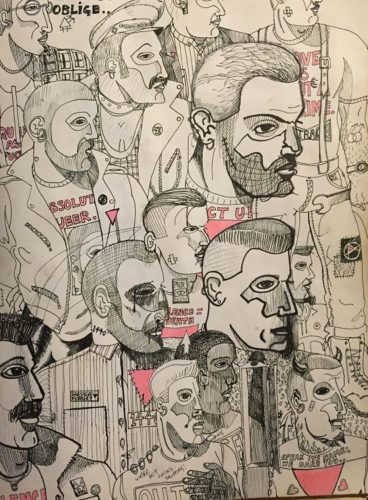
International Holocaust Remembrance Day (Jan. 27) honors the victims of the Nazi era, including the estimated 5,000 to 60,000 sent to concentration camps for homosexuality.
The United Nations set the date as the anniversary of the liberation of the Auschwitz-Birkenau, the largest Nazi death camp, in 1945.
Established by the UN in 2005, International Holocaust Remembrance Day recalls the state-sponsored extermination of 6 million Jews and 11 million others deemed inferior by the Nazis, including LGBTQ people, Slavic peoples, Soviet prisoners of war, Gypsies and others not of the “Aryan race,” the mentally ill, the disabled, people, and religious dissidents such as Jehovah’s Witnesses and Catholics. Holocaust Remembrance Day aims to help prevent future genocides.
Approximately 100,000 men were arrested from 1933 and 1945 under Paragraph 175, the German law against homosexuality. They were imprisoned or sent to concentration camps. Only about 4,000 survived. During the Nazi regime, some mobilized their “deviant” sexualities to counteract Nazi ideologies.
The defeat of the Nazis brought liberation for most prisoners in the concentration camps, but some of those accused of homosexuality were re-imprisoned in post-war Germany based on evidence found by the Nazis.
Artists who address LGBTQ deaths in the holocaust (or “homocaust”) include Tony O’Connell, Mary Button, William Hart McNichols, Richard Grune, John Bittinger Klomp, Keith Haring and those who designed the world’s dozens of memorials to LGBTQ Holocaust victims. Their art is featured here today.
Pink triangles turn shame to pride
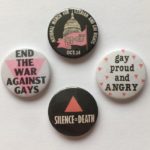
Pride buttons on Etsy
Nazis used the pink triangle to identify male prisoners sent to concentration camps for homosexuality. Originally intended as a badge of shame, the pink triangle has become a symbol of pride for the LGBTQ rights movement. Pink triangles used to be the most common LGBTQ symbol.
They show clearly in the drawing at the top of this post. Queer British artist Tony O’Connell sketched it based on attending his first Pride march — the 1992 Pride march in London. “This page from my 1992 sketchbook was influenced by men I saw on my first Pride March mixed with various gay stereotypes and historical symbols. It could become a very old distant cousin for an image of queer saints marching,” O’Connell said.
Now pink triangles have mostly been replaced by rainbows, which emphasize diversity, but don’t connect with queer history in the same way that the pink triangle does. Pink triangles live on in replicas of vintage buttons and shirts from Pride marches and protests of the past.
Holocaust art and monuments with the pink triangle
The pink triangle appears in a variety of monuments that have been built around the world to commemorate LGBTQ victims of the Nazi regime.
The world’s first LGBTQ Holocaust memorial was the Homomonument, opened in 1987 in the Netherlands. O’Connell made a photo and video record of his prayers and offerings at the Homomonument in Amsterdam on Christmas Day 2014 as part of his contemporary performance art series of LGBTQ pilgrimages.
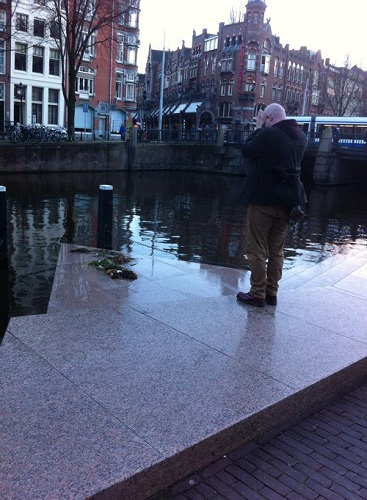
Holocaust Memorial Pilgrimage to Homomonument in Amsterdam by Tony O’Connell
O’Connell visits LGBTQ historical sites such as the Harvey Milk Metro station in San Francisco, New York City’s Stonewall Inn, and the Alan Turing Memorial Bench in Manchester. Democratizing the idea of sacredness and reclaiming the holiness in ordinary life, especially in LGBTQ experience, are major themes in O’Connell’s work. Based in Liverpool, O’Connell was raised in the Roman Catholic church, but has been a practicing Buddhist since 1995. For more info about O’Connell’s art, see my previous post Codebreaker Alan Turing honored in queer pilgrimage by artist Tony O’Connell.
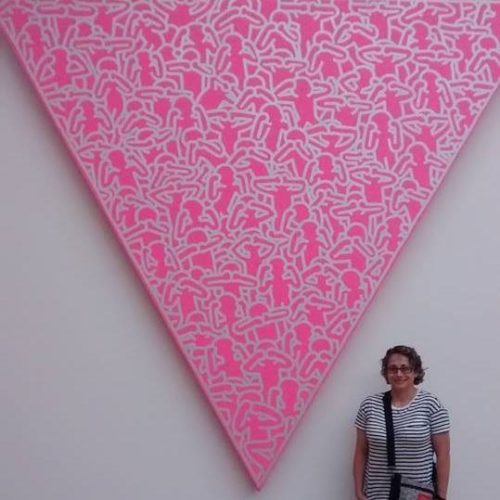
“Silence = Death” by Keith Haring (1988) is shown here at a 2016 exhibit in Munich, Germany. Photo courtesy of Steph Budwey.
Pink triangles are featured in the work of various artists, including Keith Haring (1958-1990), one of the most well-known gay artists of the 20th century. Works such as his 1988 “Silence = Death” draw a parallel between the Nazi holocaust and the oppression and invisibility of people with AIDS. He did multiple versions in different sizes. They show a pink triangle overlaid with figures covering their eyes, ears and mouths.
Another painting on the theme is “Pink Triangle” by John Bittinger Klomp, a gay artist based in Florida.
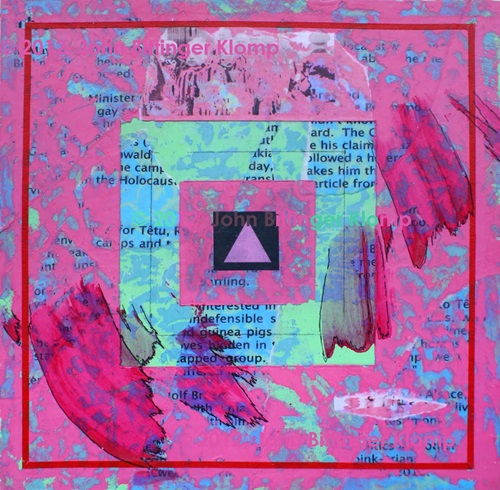
“Pink Triangle” by John Bittinger Klomp, 2012
“The Pink Triangle was part of the system of triangles used by the Nazis during World War II to denote various peoples they deemed undesirable, and included Jews, Jehovah’s Witnesses and homosexuals,” Klomp said. The painting is part of his “Gay Dictionary Series” on words and symbols related to being gay.
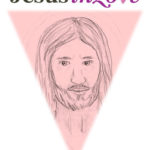 The original logo for the Jesus in Love Blog also shows the face of Jesus in a pink triangle. He joins queer people in transforming suffering into power.
The original logo for the Jesus in Love Blog also shows the face of Jesus in a pink triangle. He joins queer people in transforming suffering into power.
In January 2014 Israel’s first memorial for LGBT victims of the Holocaust was unveiled in Tel Aviv. Since 1984, more than 20 gay Holocaust memorials have been established in places ranging from San Francisco to Sydney, from Germany to Uruguay. Some are in the actual concentration camp sites, such as the plaque for gay victims in Dachau pictured below.
To see powerful photos of all the queer Holocaust memorials and read the stories behind them, visit:
http://andrejkoymasky.com/mem/holocaust/ho08.html
Priest who wore the pink triangle
A gay priest who was killed in the Holocaust is honored in the icon “Holy Priest Anonymous One of Sachsenhausen.” It was painted by Father William Hart McNichols, a New Mexico artist and Catholic priest who was rebuked by church leaders for his LGBTQ-affirming icons of unapproved saints. The icon of the anonymous priest of Sachsenhausen icon appears in the book “The Bride: Images of the Church,” which McNichols co-authored with peace activist Daniel Berrigan.
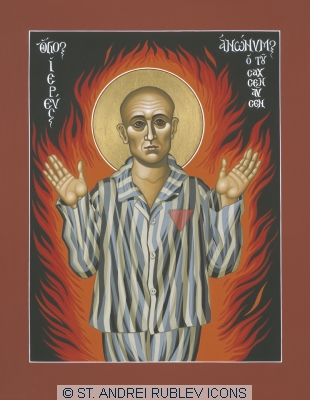
A gay priest killed in the Holocaust appears in “Holy Priest Anonymous One of Sachsenhausen” by William Hart McNichols
The anonymous 60-year-old gay priest, beaten to death because he refused to stop praying at the concentration camp in Sachsenhausen, Germany. Eyewitness Heinz Heger reported that the murder was so brutal that “I felt I was witnessing the crucifixion of Christ in modern guise.”
Here is the beginning of his tragic story, as told by Heger in his book The Men With the Pink Triangle.
Toward the end of February, 1940, a priest arrived in our block, a man some 60 years of age, tall and with distinguished features. We later discovered that he came from Sudetenland, from an aristocratic German family.
He found the torment of the arrival procedure especially trying, particularly the long wait naked and barefoot outside the block. When his tonsure was discovered after the shower, the SS corporal in charge took up a razor and said “I’ll go to work on this one myself, and extend his tonsure a bit.” And he saved the priest’s head with the razor, taking little trouble to avoid cutting the scalp. quite the contrary.
The priest returned to the day-room of our lock with his head cut open and blood streaming down. His face was ashen and his eyes stared uncomprehendingly into the distance. He sat down on a bench, folded his hands in his lap and said softly, more to himself than to anyone else: “And yet man is good, he is a creature of God!”
The book goes on to recount in heartbreaking detail how the Nazis tortured the priest, hurling anti-gay slurs and beating him to death. More excerpts are available at the Queering the Church Blog in a post titled The Priest With the Pink Triangle.
More artwork remembering LGBTQ people in the Holocaust
Persecution of LGBTQ people during the Holocaust is juxtaposed with the suffering of Jesus in two paintings from “Stations of the Cross: The Struggle For LGBT Equality” by Mary Button. In Station 3, Jesus falls the first time and Nazis ban homosexual groups. The painting features headshots of men who were arrested for homosexuality under Paragraph 175 of the German criminal code and sent to concentration camps between 1933 and 1945.
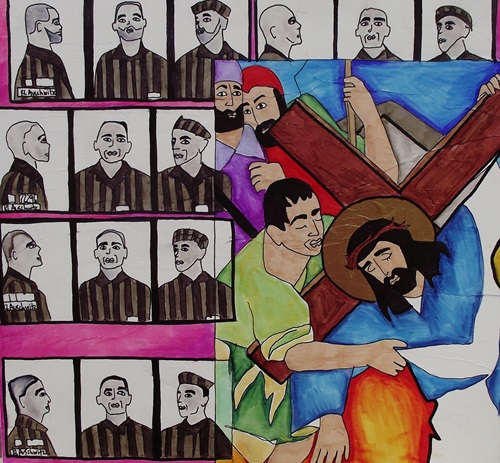
Station 3 from “Stations of the Cross: The Struggle For LGBT Equality” by Mary Button, courtesy of Believe Out Loud
In Station 4, Jesus meets his mother and LGBTQ prisoners are kept in Nazi concentration camps after Allied liberation. Nazis and Allies were enemies, but they agreed that homosexuals should be locked up. The Allies liberated everyone else, but kept those who wore the pink triangle in prison. Upon liberation of Nazi concentration camps, those interned for homosexuality were not freed, but required to serve out the full term of their sentences under Paragraph 175. The painting shows railroad tracks leading to the gas chambers at Auschwitz-Birkenau concentration and extermination camp, uniforms with pink triangles, and the Nazi chart of symbols used to classify prisoners.
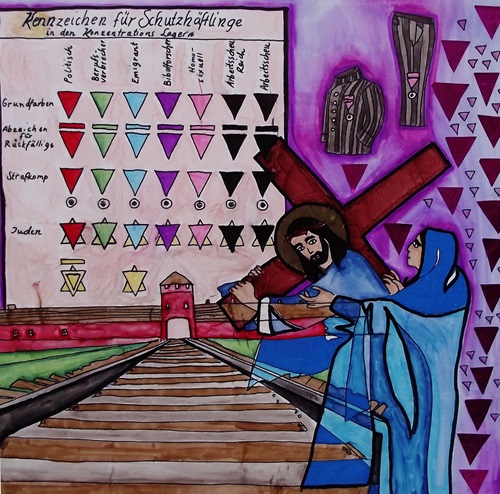
Station 4 from “Stations of the Cross: The Struggle For LGBT Equality” by Mary Button, courtesy of Believe Out Loud
Using bold colors and collage, Button puts Jesus’ suffering into a queer context by matching scenes from his journey to Golgotha with milestones from the last 100 years of LGBTQ history. For an overview of all 15 paintings in the LGBT Stations series, see my article LGBT Stations of the Cross shows struggle for equality.
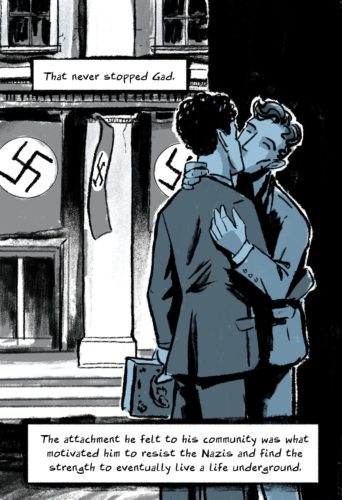
A scene from “The Life of Gad Beck: Gay. Jewish. Nazi Fighter.” by Dorian Alexander and Levi Hastings (theNib.com)
Powerful images of gay Jewish resistance appear in “The Life of Gad Beck: Gay. Jewish. Nazi Fighter,” a non-fiction comic by Dorian Alexander and Levi Hastings. It was first posted online for Holocaust Remembrance Day 2019.
 It open with the lines, “When we think of queer people and the Holocaust, it’s hard to think of anything but victimization. But that would be a mistake.” It goes on to show the inspiring story of how Beck resisted and survived the Nazis.
It open with the lines, “When we think of queer people and the Holocaust, it’s hard to think of anything but victimization. But that would be a mistake.” It goes on to show the inspiring story of how Beck resisted and survived the Nazis.
Beck also tells his own story in his 2000 autobiography titled An Underground Life: Memoirs of a Gay Jew in Nazi Berlin.
Richard Grune, a Bauhuas-trained German artist sent to Nazi concentration camps for homosexuality, also saw a connection between Christ’s Passion and the suffering of people in the camps. After being imprisoned in Sachsenhausen and Flossenbürg, he created “Passion of the 20th Century,” a set of lithographs depicting the nightmare of life in the camps. Published in 1947, it is considered one of the most important visual records of the camps to appear in the immediate postwar years.
 |
| Willem Ardondeus |
A gay Dutch artist who died in the Holocaust was Willem Arondeus (Aug. 22, 1894 – July 1, 1943). He participated in the anti-Nazi resistance movement with openly lesbian cellist Frieda Belinfante and others. Arondeus was openly gay before World War II began and proudly asserted his queer identity in his last message before his execution: “Let it be known that homosexuals are not cowards.” His life and art are featured in a YouTube video.
Lesbians in the Holocaust
The Nazis also denounced and attacked lesbians, but usually less severely and less systematically than they persecuted male homosexuals. Their history is told online in the article Lesbians Under the Nazi Regime at the US Holocaust Museum. Some lesbians claim the black triangle as their symbol. The Nazis imposed the black triangle on people who were sent to concentration camps for being “anti-social.”
Eve Adams, also known as Eva Kotchever, was a Polish Jewish immigrant to New York City, where she wrote the groundbreaking book “Lesbian Love” in 1925 and ran an openly lesbian literary salon in 1925-26. She was convicted of obscenity and disorderly conduct, and deported back to Europe. This led to her arrest and death in Auschwitz on Dec. 19, 1943. Her story is told in the 2021 book “The Daring Life and Dangerous Times of Eve Adams” by Jonathan Ned Katz, published by Chicago Review Press.
A lesbian couple, both artists, used their creativity to resist the Nazis during World War II. Their story is told in the 2020 book “Paper Bullets: Two Artists Who Risked Their Lives to Defy the Nazis” by Jeffrey H. Jackson. French avant-garde artists Lucy Schwob and Suzanne Malherbe were imprisoned and sentenced to death, but kept resisting and managed to survive. The lesbian partners were known for cross-dressing and creating the kind of queer work that the Nazis would come to call “degenerate art.” They attended political rallies in Paris and socialized with artists such as Gertrude Stein. The author is a history professor at Rhodes College in Memphis, Tennessee.
Memoirs of gay Holocaust survivors
The last surviving man to wear the pink triangle in the concentration camps was Rudolf Brazda, who died in 2011 at age 98.
 The award-winning 1979 play “Bent” by Martin Sherman helped increase awareness of Nazi persecution of gays, leading to more historical research and education. A film version of “Bent” was made in 1997 with an all-star British cast including Clive Owen, Mick Jagger and Jude Law. Its title comes from the European slang word “bent” used as a slur for homosexuals.
The award-winning 1979 play “Bent” by Martin Sherman helped increase awareness of Nazi persecution of gays, leading to more historical research and education. A film version of “Bent” was made in 1997 with an all-star British cast including Clive Owen, Mick Jagger and Jude Law. Its title comes from the European slang word “bent” used as a slur for homosexuals.
The 2000 documentary film “Paragraph 175” tells the stories of several gay men and one lesbian who were persecuted by the Nazis, including interviews with some of the last survivors.
In recent years new memoirs of gay Holocaust survivors have been published and queer theory has brought new understanding of the Gay Holocaust as not just atrocities, but also a system of social control. Valuable books include:
I, Pierre Seel, Deported Homosexual: A Memoir of Nazi Terror by Pierre Seel (2011)
Lost Intimacies: Rethinking Homosexuality under National Socialism by William J. Spurlin (2008)
“The Hidden Holocaust?: Gay and Lesbian Persecution in Germany 1933-45” by Gunter Grau (1995)
The Pink Triangle: The Nazi War Against Homosexuals by Richard Plant (1988) — first comprehensive book on the subject
“Homosexuality d Male Bonding in Pre-Nazi Germany: The Youth Movement, the Gay Movement, and Male Bonding Before Hitler’s Rise” by Hubert Kennedy (1992)
Josef Jaeger by Jere’ M Fishback (young adult novel based partly on the life of Jürgen Ohlsen, Nazi propaganda film star who turned out to be gay)
A Prayers for Holocaust Remembrance
International Holocaust Remembrance Day is a suitable time for LGBTQ Christians and their allies to remember and repent the role of churches in fostering the antisemitism that led to the Holocaust. This day is devoted to the Nazi Holocaust, but it is important to remember that genocide and murder based on discrimination happened in many times and places. The list of queer martyrs executed for homosexuality is long.
Litany of Queer Saints prayer
Q Spirit’s Litany of Queer Saints includes this line:
“Martyrs of the pink triangle and the black triangle, sent to concentration camps by the Nazis for homosexuality, pray for us.”
Equal Rites prayer
Here International Holocaust Remembrance Day is observed here with the prayer “We All Wear the Triangle” by Steve Carson. It appears in the book “Equal Rites: Lesbian and Gay Worship, Ceremonies, and Celebrations.” Carson was ordained by Metropolitan Community Churches and served congregations in New York, Boston and San Francisco.
___
One: We are in many ways a culture without memory. The Holocaust, a series of events that occurred just over a generation ago, changed the world forever. Yet by some the Holocaust is forgotten, or seen as irrelevant, or even viewed as something that never happened.
All: As people of faith, we refuse to forget. We refuse to participate in the erasing of history. As a community of faith, we decide to remember, as we hear the historical record from Europe a generation ago and reflect upon events in our own time. We dare to listen to the voices of the past, even as they echo today.
One: In this moment, we are all Jews wearing the yellow Star of David.
All: We are all homosexuals wearing the pink triangle.
One: We are all political activists wearing the red triangle.
All: We are all criminals wearing the green triangle.
One: We are all antisocials wearing the black triangle.
All: We are all Jehovah’s Witnesses wearing the purple triangle.
One: We are all emigrants wearing the blue triangle.
All: We are all gypsies wearing the brown triangle.
One: We are all undesirable, all extendable by the state.
…Leader: To God of both memory and hope, we pledge ourselves to be a people of resistance to the powers of death wherever they may appear, to honor the living and the dead, and to make with them our promise: Never again!
Believe Out Loud prayer
Believe Out Loud shared a multi-faith prayer for International Holocaust Remembrance Day 2022. It commemorates all lives lost in the Holocaust with an emphasis on the LGBTQIA community. The prayer is read aloud by Jewish, Christian and Muslim leaders in North America and in Germany in the video version.
The full prayer text is posted online at Believe Out Loud. It includes these lines:
We cry for the looting, closing, and burning of the extensive collection in the Institute for Sexual Science.
We cry for the 15,000 who were accused of homosexuality and deported to concentration camps where they died, mostly from exhaustion….
We stand in awe and gratitude of your persistent love for each and all your children: Jewish, Muslim, Christian, and queer too.
We are all precious manifestations of the Divine.
Links related to Nazi persecution of Homosexuals
Nazi Persecution of Homosexuals 1933-45 (US Holocaust Museum)
Pink Triangle at the Legacy Walk
Persecution of Homosexuals in Nazi Germany and the Holocaust (Wikipedia)
Sachsenhausen (Counterlight’s Peculiars).
___
To read this article in Italian, go to:
Quando l’arte fa memoria dell’Olocausto dei triangoli rosa (gionata.org)
___
Top image credit:
“Sketchbook page 1992” by Tony O’Connell is inspired by the 1992 Pride March in London.
___
This post is part of the LGBTQ Calendar series by Kittredge Cherry. The series celebrates religious and spiritual holidays, events in LGBTQ history, holy days, feast days, festivals, anniversaries, liturgical seasons and other occasions of special interest to lesbian, gay, bisexual, transgender and queer people of faith and our allies.
The first version of this article was posted in April 2010 on the Jesus in Love blog and updated regularly with new material. It was published on Q Spirit in January 2017, was expanded with new material over time, and was most recently updated on Jan. 26, 2025.
Copyright © Kittredge Cherry. All rights reserved.
Qspirit.net presents the Jesus in Love Blog on LGBTQ spirituality.




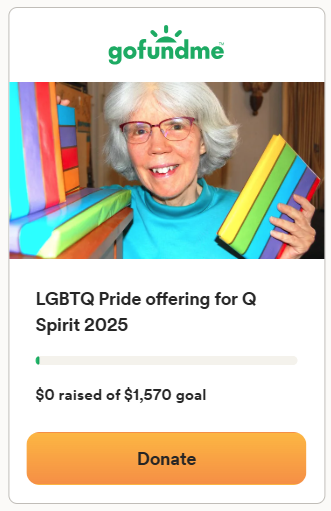


















What a beautiful haunting article. Thank you so much for this. To think that the Nazi’s are now marching fully out there in the streets of America makes me shudder. We just had a crew of them march through Hartford Ct. A member of the same group was responsible for the murder of Heather Heyer. Their manifesto sounds like a page from 1933-. To think some folks around here say, “Ignore them, they will go away.” Hopefully they will not in the future say, “We didn’t know.” Here in Ct. The Legion of Queer Anarchists has done research on this group. There facebook page is https://www.facebook.com/Legion-of-Queer-Anarchists-CT-143327336370759/ just scroll down a bit and you will find the article and some of their writing. They must be stopped.
this is an incredibly powerful article. I think LGBT people who see a danger in the presence of Neo-Nazis on our streets are absolutely correct. You are right to shudder; I shudder when I see them, too. But so many wish to deny that such danger exists. My wife refuses to listen. She says everything is going to be all right. However, everything will NOT be all right if we do not recognize the danger and do whatever we can to expose and to fight it. I think that vulnerable groups ignore this sickening phenomenon at their own risk.
So many died at the hands of such butchers.